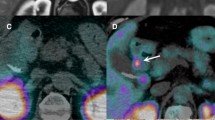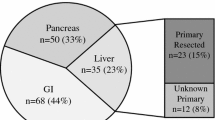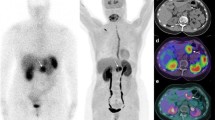Abstract
Background
The precise localization of the primary tumor and/or the identification of multiple primary tumors improves the preoperative work-up in patients with small bowel (SB) neuroendocrine tumor (NET). The present study assesses the diagnostic value of 18F-fluorodihydroxyphenylalanine (18F-FDOPA) positron emission tomography/computed tomography (PET/CT) during the preoperative wok-up of SB NETs.
Methods
Between January 2010 and June 2017, all consecutive patients with SB NETs undergoing preoperative 18F-FDOPA PET/CT and successive resection were analyzed. Preoperative work-up included computed tomography (CT), somatostatin receptor scintigraphy (SRS), and 18F-FDOPA PET/CT. Sensitivity and accuracy ratio for primary and multiple tumor detection were compared with data from surgery and pathology.
Results
There were 17 consecutive patients with SB NETs undergoing surgery. Nine patients (53%) had multiple tumors, 15 (88%) metastatic lymph nodes, 3 (18%) peritoneal carcinomatosis, and 9 patients (53%) liver metastases. A total of 70 SB NETs were found by pathology. Surgery identified the primary in 17/17 (100%) patients and recognized seven of 9 patients (78%) with multiple synchronous SB. Preoperatively, 18F-FDOPA PET/CT displayed a statistically significant higher sensitivity for primary tumor localization (100 vs. 23.5 vs. 29.5%) and multiple tumor detection (78 vs. 22 vs. 11%) over SRS and CT. Compared with pathology, 18F-FDOPA PET/CT displayed the highest accuracy ratio for number of tumor detected over CT and SRS (2.0 ± 2.2 vs. 0.4 ± 0.7 vs. 0.6 ± 1.5, p = 0.0003).
Conclusion
18F-FDOPA PET/CT significantly increased the sensitivity and accuracy for primary and multiple SB NET identification. 18F-FDOPA PET/CT should be included systematically in the preoperative work-up of SB NET.



Similar content being viewed by others
References
Wang SC, Parekh JR, Zuraek MB, et al. Identification of unknown primary tumors in patients with neuroendocrine liver metastases. Arch Surg. 2010;145:276–280.
Modlin IM, Oberg K, Chung DC, et al. Gastroenteropancreatic neuroendocrine tumours. Lancet Oncol. 2008;9:61–72.
Capurso G, Rinzivillo M, Bettini R, Boninsegna L, Delle Fave G, Falconi M. Systematic review of resection of primary midgut carcinoid tumour in patients with unresectable liver metastases. Br J Surg. 2012;99:1480–1486.
Partelli S, Bartsch DK, Capdevila J, et al. ENETS consensus guidelines for standard of care in neuroendocrine tumours: surgery for small intestinal and pancreatic neuroendocrine tumours. Neuroendocrinology. 2017;105:255–265.
Yantiss RK, Odze RD, Farraye FA, Rosenberg AE. Solitary versus multiple carcinoid tumors of the ileum. A clinical and pathologic review of 68 cases. Am J Surg Pathol. 2003; 27:811–817.
Bonekamp D, Raman SP, Horton KM, Fishman EK. Role of computed tomography angiography in detection and staging of small bowel carcinoid tumors. World J Radiol. 2015;7:220–235.
Yamagishi H, Fukui H, Shirakawa K, et al. Early diagnosis and successful treatment of small-intestinal carcinoid tumor: useful combination of capsule endoscopy and double-balloon endoscopy. Endoscopy. 2007;39 Suppl 1:E243-E244.
Pasquier A, Walter T, Hervieu V, et al. Surgical management of small bowel neuroendocrine tumors: specific requirements and their impact on staging and prognosis. Ann Surg Oncol. 2015;22 suppl 3:742–749.
Santhanam P, Chandramahanti S, Kroiss A, et al. Nuclear imaging of neuroendocrine tumors with unknown primary: why, when and how? Eur J Nucl Med Mol Imaging. 2015;42:1144–1155.
Deroose CM, Hindié E, Kebebew E, et al. Molecular imaging of gastroenteropancreatic neuroendocrine tumors: current status and future directions. J Nucl Med. 2016;57:1949–1956.
Koopmans KP, de Vries EG, Kema IP, et al. Staging of carcinoid tumours with 18FDOPA PET: a prospective, diagnostic accuracy study. Lancet Oncol. 2006;7:728–734.
Imperiale A, Rust E, Gabriel S, et al. 18F-fluorodihydroxyphenylalanine PET/CT in patients with neuroendocrine tumors of unknown origin: relation to tumor origin and differentiation. J Nucl Med. 2014;55:367–372.
Imperiale A, Averous G, Chilinseva-Natorov N, et al. Unknown multifocal ileal carcinoid revealed by (18)F-FDOPA PET/CT. J Clin Endocrinol Metab. 2014;99:1510–1511.
Helali M, Heimburger C, Rohr S, Goichot B, Imperiale A. Small Bowel Carcinoid: The “Dancing Bowel Sign” on 18FFDOPA PET/CT Clin Nucl Med. 2016;41:944–945.
Sei Y, Zhao X, Forbes J, et al. A hereditary form of small intestinal carcinoid associated with a germline mutation in inositol polyphosphate multikinase. Gastroenterology. 2015;149:67–78.
Ambrosini V, Tomassetti P, Rubello D, et al. Role of 18F-dopa PET/CT imaging in the management of patients with 111In-pentetreotide negative GEP tumours. Nucl Med Commun. 2007;28:473–477.
Jager PL, Chirakal R, Marriott CJ, Brouwers AH, Koopmans KP, Gulenchyn KY. 6-L-18F-fluorodihydroxyphenylalanine PET in neuroendocrine tumors: basic aspects and emerging clinical applications. J Nucl Med. 2008;49:573–586.
Fiebrich HB, de Jong JR, Kema IP, et al. Total (18)F-dopa PET tumour uptake reflects metabolic endocrine tumour activity in patients with a carcinoid tumour. Eur J Nucl Med Mol Imaging. 2011;38:1854–1861.
Sadowski SM, Neychev V, Millo C et al. Prospective study of 68Ga-DOTATATE positron emission tomography/computed tomography for detecting gastro-entero-pancreatic neuroendocrine tumors and unknown primary sites. J Clin Oncol. 2016;34:588–596.7
Strosberg JR, Weber JM, Feldman M, Coppola D, Meredith K, Kvols LK. Prognostic validity of the American Joint Committee on Cancer staging classification for midgut neuroendocrine tumors. J Clin Oncol. 2013;3:420–425.
Bartlett EK, Roses RE, Gupta M, et al. Surgery for metastatic neuroendocrine tumors with occult primaries. J Surg Res. 2013;184:221–227.
Hoffman EJ, Huang SC, Phelps ME. Quantitation in positron emission computed tomography: 1. Effect of object size. J Comput Assist Tomogr 1979;3:299–308.
Pasquer A, Walter T, Rousset P, et al. Lymphadenectomy during small bowel neuroendocrine tumor surgery: the concept of skip metastases. Ann Surg Oncol. 2016;23:804–808.
Ethun CG, Postlewait LM, Baptiste GG, et al. Small bowel neuroendocrine tumors: a critical analysis of diagnostic work-up and operative approach. J Surg Oncol. 2016;114:671–676.
Figueiredo MN, Maggiori L, Gaujoux S, et al. Surgery for small-bowel neuroendocrine tumors: is there any benefit of the laparoscopic approach? Surg Endosc. 2014;28:1720–1726.
Acknowledgements
The authors thank Gerlinde Averous, MD, and Marie Pierrette Chenard, MD, from the Department of Pathology, University Hospitals of Strasbourg, for pathological examinations of surgical specimens.
Author information
Authors and Affiliations
Contributions
Substantial contributions to the conception or design of the work: PA, GP, BG, LL, CB, DM, BR, IJN, PB, and AI.
Acquisition, analysis, or interpretation of data for the work; PA, GP, BG, LL, CB, DM, BR, IJN, PB, and AI.
Drafting the work or revising it critically for important intellectual content: PA, GP, BG, LL, CB, DM, BR, IJN, PB, and AI.
Final approval of the version to be published: PA, GP, BG, LL, CB, DM, BR, IJN, PB, and AI.
Agreement to be accountable for all aspects of the work in ensuring that questions related to the accuracy or integrity of any part of the work are appropriately investigated and resolved: PA, GP, BG, LL, CB, DM, BR, IJN, PB, and AI.
Corresponding author
Rights and permissions
About this article
Cite this article
Addeo, P., Poncet, G., Goichot, B. et al. The Added Diagnostic Value of 18F-Fluorodihydroxyphenylalanine PET/CT in the Preoperative Work-Up of Small Bowel Neuroendocrine Tumors. J Gastrointest Surg 22, 722–730 (2018). https://doi.org/10.1007/s11605-017-3645-1
Received:
Accepted:
Published:
Issue Date:
DOI: https://doi.org/10.1007/s11605-017-3645-1




